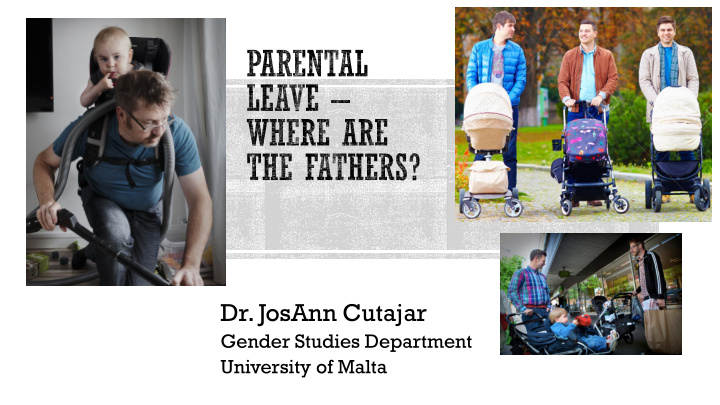



Dr. JosAnn Cutajar Gender Studies Department University of Malta
Fa 88.1388.13% OF FFMS USED BY WOMEN Low uptake among fathers where parental leave is concerned IN 2014% OF FFMS USED BY WOMEN In 2014 family friendly measures were mainly accessed by women 2014 IN 2014
In Japan and S. Korea 1 year of paid leave is reserved for the father ₅ Quebec – fathers and mothers can share 32 weeks Fathers get 5 weeks of paternity leave at 70% of their income Mother may forgo 25 weeks of parental leave if she earns more money Norway – 9 out of 10 dads take at least 12 weeks of paid paternity leave ₃ In Sweden fathers need to use a minimum of 8 weeks before they can transfer what remains of their 32 weeks paid leave to partner ₄ In Canada men and women can share 25 weeks of paid parental leave at 55% of their income ₂ On top of this women get 10 sickness and 15 maternity weeks Denmark – 90% of dads take more than a fortnight ’s leave ¹
Both Partners Children Companies Economy
Benefit from high employee morale, loyalty and retention Avoid costly turnover and training costs Retain valued expertise, skills and perspectives¹ Attract the best people Survey among 1,000 working fathers found that 9 out of 10 said that paternity leave was seen as important when it came to choosing a job. Paid parental leave benefitted small businesses who were able to attract talent but were not able to offer high wages ₂
Decline in birthrate , postponing having children – drastic consequences for economy Forward thinking companies take an active role in relieving pressures from young couples Help them by supplementing government paid parental leave Covering portions of fertility treatment and adoption costs Fewer workers = fewer consumers Contributing to better birthrate = invest in business prosperity
90% of employers reported positive or no noticeable effect on profitability, turnover or morale ¹ Survey among 253 firms in the USA showed that paid leave had minimal impact on business operations according to employers ₂ 9 out of 10 had neutral or positive impact on business profits and employee productivity
The more fathers are involved with their children, the less they will suffer from depression and substance abuse ¹ Sustain healthier relationship with partner Fewer divorce rates Report greater life satisfaction and better physical and mental health (OECD, 2016) Happy family lives mean happy more productive employees
Better child health (Ruhm, 2000) Better father-child relatio nships when fathers take more than two weeks paternity leave (Nepomnyaschy & Waldfogel, 2007) Children enjoy higher cognitive and emotional outcomes (OECD, 2016) Paternity leave improved children’s performance at secondary school ¹ Daughters flourish in the workplace when dads participated more at home (Croft et al., 2014) Reduction of family poverty when both parents can have children and stay in employment (OECD, 2016) When paternity leave is short and poorly paid, only richer dads can afford to take time off
Maternity leave has an adverse effect on women’s careers¹ Less job security Motherhood penalty on wages Less likely to be promoted For every month the father took paternity leave, the mother’s earnings increased by 7% ₂ Daddy quota in Quebec (five weeks of paid leave) helped mothers retain full- time employment ₃ In Quebec women’s earnings increased by 25% when partner used leave Fathers who took parental leave increased the time they spent on household duties
Offering flexitime¹ Telecommunicating opportunities Organizing support groups and providing informative collateral (pamphlets, posters, flyers, workshops) to help challenge traditional social barriers that keep fathers from taking on caring roles Offering onsite daycare and/or after school childcare, new parent support network, increase time limit or the salary percentage of parental leave ₂
Provide financial incentives - 86% of men surveyed said that they wouldn’t use paternity/parental leave if they did not at least receive 70% of normal salary (Harrington et al., 2015) Uptake by men was higher when paternal leave was paid around half or more of previous earnings (OECD, 2016) Reserve specific non-transferable periods for fathers/other partners Helps legitimize the concept Some countries offer bonus periods to couple when father uses a certain amount of sharable leave Ensure that there are flexible or part-time leave arrangements
Dr. JosAnn Cutajar
Recommend
More recommend